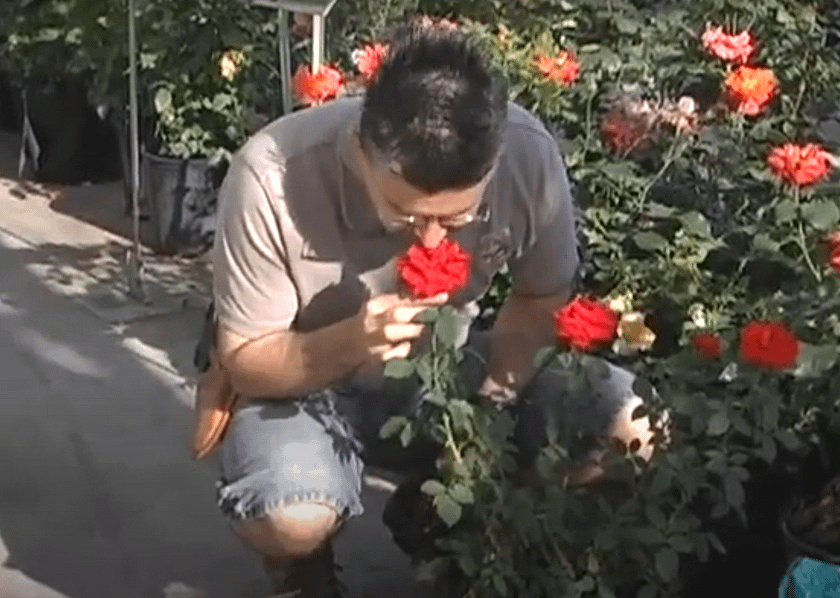Caring For Roses

Watering affects the success of your roses more than any other thing. Roses need 1 to 2 inches of water each week, preferably all at one time. Hot, dry weather (as well as a very porous soil) will make it necessary to water more frequently. The best method for watering is a soaker hose or drip system. Whatever method you choose, be sure to water deeply. Frequent light sprinklings are worse than no water at all.
Mulching–spreading a protective covering on top of the soil can help the rose gardener in numerous ways. Not only does it provide a neat, attractive appearance to the bed, but it slows the evaporation of moisture from the soil, it insulates the soil, and it is invaluable in weed control. You can use an organic mulch like bark, or a redwood soil conditioner, or an inorganic mulch like landscaping fabric (it resembles black plastic, but lets water and fertilizer pass through while blocking weeds and grasses). If you have had trouble with diseases in the past, be sure to change your organic mulch every year, removing old dead leaves and debris.
Another key element to a rose’s development is pruning. This should be done in mid-late April. Always use sharp, clean, well-maintained tools. You will probably need a hand pruner, a lopper for thick canes and hard-to-reach places, and a curved saw for woody canes. Always make your cuts at sharp, 35- to 45- degree angles, about a quarter-inch above a bud. Notice the direction in which the bud is pointing. Prune to encourage outward-facing buds so that you do not end up with a tangle of canes. To ensure a clean cut, position the cutting blade on the side closer to the bud. Also, when cutting flowers, leave at least two 5-leaflet leaves to remain on the plant stem after your cut.

Most roses need regular applications of fertilizer once a month from April to July to resist damage from insects, diseases, and cold weather. Many gardeners rely on two kinds of fertilizers for their roses: a complete, dry fertilizer and supplemental applications of a quick-acting liquid fertilizer. Moisten the soil before applying a dry fertilizer and water again immediately after to carry the nutrients to the roots. Do not spray liquid fertilizers on the foliage on hot (over 85˚) days. Whatever fertilizer you use, follow the directions on the label. Overfertilization and fertilizing at the wrong time (for example, too late in the fall) can severely damage your valuable plants.
The best way to control bugs and diseases on your roses is prevention. Healthy and vigorous roses can withstand more injury than a plant that is stressed and neglected. Four simple steps will help you prevent insect and disease infestations before they occur. First, water correctly. If you water with sprinklers, water in the morning so the foliage can dry before night. Any splashing of water from the soil or mulch can also spread diseases. Second, prune throughout the season. Remove all damaged or diseased canes and leaves as soon as you notice them. This will help prevent the spread of many diseases. Third, don’t forget to do a winter cleanup. If you clean up the debris (leaves and twigs) in the spring while the plants are still dormant, you will have less insects and fewer disease organisms around to trouble your plants. And finally, establish a routine schedule for pest and disease control during the season. Systemic sprays or granules, and organic and chemical sprays have been formulated for the protection of your roses. If used properly, you may never see any evidence of pest of disease if you take the time to apply a maintenance spray or dust every two weeks or so.

Aside from all the traditional methods of protecting roses (mulches of leaves or peat, rose collars and domes, mounds of soil, and insulating fabrics, etc.), a late Fall application of Magnesium Sulfate, Muriate of Potash, Ocean Kelp Meal, and other sources of natural, slow-release nutrients will provide the roses with the necessary elements that they need for proper growth next year. It is also believed that these nutrients will make the roses one full zone hardier through the winter.
For a more traditional approach to rose protection, first start by not pruning your roses at all. Leave the dead, dried up blossoms right on the bushes, allowing them to form hips. This helps the rose prepare for winter and go dormant more rapidly. If the canes are extremely long and susceptible to breakage from snow, then prune them sparingly in November when the plant has gone completely dormant. Next, gather up all the leaves you can find and, with the help of rings of chicken wire, rose collars or cardboard boxes to hold them in place, pack the leaves in around the roses to the depth of about 14-18 inches. This will insulate the graft through winter and help protect your bushes from damage. Lots of snow cover helps too, so don’t complain too much about the snow, it actually helps protect all your plants from freezing.

